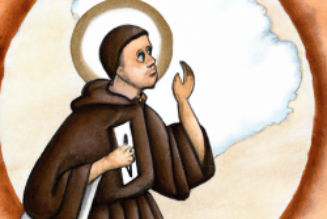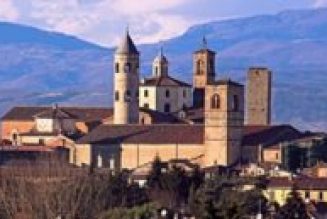
When one goes to the outskirts of the city of Rome along the Via Laurentina, one finds two significant sites that are reminders of the power of the Sacred Heart of Jesus. The first site is the Trappist Monastery of Tre Fontane that houses three churches—the most famous of which being the Church of St. Paul at Tre Fontane. This Church marks the spot where the great persecutor-turned-Apostle to the Gentiles,1 was beheaded by the Romans for the glory of Our Lord and the sake of the Gospel.2
Around the corner from this shrine, another Saul-like persecutor had his own a Paul-like conversion through the merits of the Sacred Heart of Jesus and the intercession of Our Lady. This “Saul” was Bruno Cornacchiola, a member of the Seventh Day Adventist Church and a Roman trolley driver. Cornacchiola’s story includes some notable apparitions of the Blessed Virgin, under the title of Our Lady of Revelation in Tre Fontane.
As the Church and the world begin to open up again with the lifting of COVID-19 quarantines, it is worth looking at these private revelations to Cornacchiola. They have some profound connections worth bringing to prayer during this month of June, where we celebrate the Feasts of Corpus Christi, the Sacred Heart of Jesus, and Saints Peter and Paul.
Bruno grew up in Rome and came from a poor, nominally Catholic family. His father was an atheist and a drunk and his mother worked outside the home, unable to focus enough on her own children’s upbringing. Bruno was named after Giordano Bruno, the infamous Italian Dominican heretic.3 Cornacchiola became a street urchin, receiving little formation in the way of faith or virtue.4 A Maria Farseti helped him prepare for his first Holy Communion. These Communion lessons awakened Bruno to the reality of Our Lord’s loving presence in his life and he sought to live out that faith anew by asking his family for forgiveness for the times that he sinned against them. When Bruno returned home from receiving Our Lord for the first time, he asked his parents for forgiveness for his sins. They ridiculed and rejected him, which scarred Bruno for the rest of his life.5 We can see callousness, anger, fear, and aloofness as things that can snuff out faith both in us and in others.
Bruno became a professed atheist, then a communist spy within the Italian Fascist Army during the Spanish Civil War. During his service in the army, he met a German Nazi officer who would convince him to become Protestant and stoke an anti-Catholic, anti-papal furor in his heart that became a motivator for much of his early life. Murderous threats arose in his heart that were similar to those that Saul once had.6 Bruno would even go as far as to buy a dagger from an armory in Toledo, Spain upon which he wrote “Death to the Pope.” Bruno would also write, “In order to save humanity I shall have to kill all priests everywhere; I shall try to destroy the Catholic Church in every way and it will be my duty to stab the pope.”7
When he came back from the war, Bruno told Iolanda, his wife, that he intended to become Protestant. He did everything in his power to destroy his wife’s Catholic faith and convert her to Protestantism. Bruno became an angry drunk and abused his wife for her Catholic faith, ridiculing a picture of Our Lady of Pompeii that she would often pray before for her husband. Bruno took the image and burned it before her. On another occasion, Bruno destroyed a crucifix placed in their room.
His wife, at the end of her rope, one day turned to the Sacred Heart of Jesus, saying to her husband, “Bruno, you want me to join the Protestant church with you – I accept on one condition. You must go to confession and receive Communion on the nine first Fridays of the month. If at the end of this pious devotion you still want to change religion, I’ll follow you. Otherwise we shall continue in the faith of our baptism.” Bruno agreed to his wife’s proposal and made the nine first Fridays but in the end this did not change his mind. Thus, his wife went along with him in becoming Protestant.8 However, the Lord would use what seemed as a vain act of faith made by his wife in the Nine First Friday Devotion to Sacred Heart as a powerful vessel to sow seeds of redemption and repentance that would bear fruit in Bruno’s life at a later time.
Bruno would later become a Roman trolley conductor and an active member in the partito d’Azione, an Italian anti-clerical party. He was known for his drunken, abusive behavior towards his family, and often made anti-Catholic remarks on the job. All this would change on April 12, 1947 at the Grotto of Tre Fontane in Rome.
On that day, Bruno brought his three children to the grotto where they would play ball as he wrote an anti-Catholic screed against Marian devotion. He was also planning on assassinating Pope Pius XII later that year on September 8, the Feast of the Nativity of Our Lady. “Our Lady is not a virgin,” Bruno wrote, “is not immaculate, is not the Lady of the Assumption.”9 After writing that line, he would never pick up his pen to complete that speech. His children – Gianfranco, Carlo, and Isola – approached him, saying that they had lost the ball they were playing with at the time. Then gradually all three of his children would fall into ecstasy on their knees before the dirty, empty grotto, saying over and over “Beautiful Lady!”10
Thinking it was witchcraft, devils, or even a priest, Bruno screamed for whoever was doing this to his children to come out of the grotto. No one answered. Then Bruno began to despair and weep convulsively, raising his eyes to heaven and crying out, “God save us!”11 Suddenly, in an instance not unlike Saul’s conversion on the road to Damascus, Bruno saw two pure white hands move towards him and touch his face, pulling something from his eyes.
After a moment, Bruno saw a young woman wearing a white robe, a green mantle, and a pink sash, holding a Bible over her heart. This young woman said to Bruno:
I am She who is with the Holy Trinity. I am the Virgin of Revelation. You have persecuted me, enough now. Enter into the heavenly fold, which is the heavenly court of God on earth. God’s promise is and remains unchanged; you are saved for having observed the nine Fridays dedicated to the Sacred Heart. You observed them, prompted by your faithful, loving spouse before you started on your erring ways!12
Our Lady led him to a priest who reconciled Bruno and his family to the Church. After his conversion, Bruno would also later be granted an audience with Pope Pius XII on December 9, 1949, at which he would publicly reconcile with him, giving him his Protestant Bible and the knife that he hoped to kill him with.13
The story of the conversion of Bruno Cornacchiola not only underscores the importance of the familial dimension of the faith lived out in the domestic church, but also the importance of local parishes.14 As our parishes open up once again, it is important to connect with parishioners. They have been isolated from the Eucharist, their family and friends. It is fitting, then, to nourish and build them up in the basics of their faith according to the constant teachings of the Church, to continue to build and strengthen relationships, and to tend to any personal needs, while at the same time taking the proper precautions to prevent the spread of disease. If the pastors of the Church lose this opportunity by focusing on the physical level alone, or by letting unreasonable fear overtake faith, reason, and love, we risk pushing people away from the Church permanently, just as Bruno was discouraged in his own faith by his parents’ callousness, aloofness, and indifference.
Iolanda’s trust in through the First Friday Devotion to the Sacred Heart is an example of an authentic faith in the Eucharist. This devotion takes us deep into the Heart of Christ in the Eucharist, into His own act of redemption that he loves us unto death for the sake of our salvation. It reminds us that when we receive Holy Communion, we enter into a mystery that is larger than us and that is first about the espousing of the Heart of Christ to his bride the Church. This Eucharistic mystery is a pure gift of love that extends to us Our Lord himself, who can redeem even the most hardened sinner and deepest of our wounds by uniting them to the grace of His intimate, abiding presence.15 When we make this intimate gift of self to Our Lord at mass in a spirit of conversion, reparation and love, He can reconcile hearts, bring healing and salvation, and plant seeds of grace that may not bear fruit according to our timing but His loving will.16 Through our heart united to the Sacred Heart extended to us in the Eucharist, Our Lord can also turn the hardened soil in the hearts of others, the Church, and the entire world to receive the grace of conversion and redemption even in our present time.
The First Friday Devotion to the Sacred Heart also shows us the unity of the Eucharist with the Heart of Christ and the union between personal sanctification and true active participation at mass. Often in our age there can be a temptation take the Second Vatican Council’s call for “full, conscious, active participation” in a liturgy as an end unto itself.17 This temptation can reduce worship to mere self-centered, human activism that divorces the Eucharist from the day to day living out of the faith in the world and also the call of holiness that every Christian is called to embrace through the interior life. The First Friday Devotion can be a valuable aid and a vehicle of grace to help reawaken the Church to what is true active participation at mass – the union and entrustment our lives and the life of the world in the present moment to the one sacrifice of Christ on the cross that is extended to us in the Eucharist. This union can then lead to a greater outpouring of the mystery of redemption that was sealed by the pierced Sacred Heart of Jesus from which blood and water flowed to wash away our sins, to give birth to the Church and salvation to her members.18
Bruno Cornacchiola’s conversion reminds us that no sinner is out of reach of Sacred Heart of Our Lord and the Immaculate Heart of Our Lady. Our Lord himself is willing to pursue the lost sheep no matter who they may be and how far away they are. Jesus, through His Sacred Heart, invites us to cooperate in the search for the lost and hardened sinners through living our baptismal calling, praying to His Sacred Heart and the Immaculate Heart of His mother for our personal sinfulness, of those around us, and the sinfulness that plagues the humanity of the church.
May the Sacred Heart of Jesus and the Immaculate Heart of Mary, the Virgin of Revelation, transform hardened sinners, exemplified by Bruno Cornacchiola—the Saul of our age—into the saints our families and our Church so desperately needs today.
Endnotes:
If you value the news and views Catholic World Report provides, please consider donating to support our efforts. Your contribution will help us continue to make CWR available to all readers worldwide for free, without a subscription. Thank you for your generosity!
Click here for more information on donating to CWR. Click here to sign up for our newsletter.








